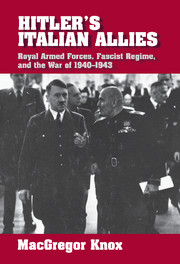Book contents
- Frontmatter
- Contents
- Acknowledgements
- List of Abbreviations
- Map
- Introduction: Defeat – and Humiliation
- 1 Fascist Italy's Last War
- 2 Society, Politics, Regime, Industry
- 3 Men and Machines: The Armed Forces and Modern Warfare
- 4 Strategy
- 5 Operations
- 6 Tactics
- Conclusion: The Weight of the Past
- Chronology
- Bibliographical Note
- Index
2 - Society, Politics, Regime, Industry
Published online by Cambridge University Press: 19 January 2010
- Frontmatter
- Contents
- Acknowledgements
- List of Abbreviations
- Map
- Introduction: Defeat – and Humiliation
- 1 Fascist Italy's Last War
- 2 Society, Politics, Regime, Industry
- 3 Men and Machines: The Armed Forces and Modern Warfare
- 4 Strategy
- 5 Operations
- 6 Tactics
- Conclusion: The Weight of the Past
- Chronology
- Bibliographical Note
- Index
Summary
Hitler's doomed allies were poor both in relative terms and in the aggregate. By the 1930s Italy was still thirty to fifty years behind Germany in becoming an industrial society – a gap overcome only in the long peace after 1945. Whereas illiteracy in Germany had virtually vanished by 1900, Italy's 1931 census registered an illiteracy rate of 20.9 percent among those over six years of age: roughly 10 percent in the North, 21 percent in the Center, and 39 percent in the South and islands. But those figures understate the gravity of the situation in the 1940s: the first postwar census, in 1951, listed 12.9 percent of Italy's population as illiterate, but also disclosed that a further 17.9 percent of the population had not completed elementary school. Almost a third (and a decade earlier, probably two-fifths) of the population was thus either illiterate or semiliterate. And by the late 1930s slightly less than a third of Italy's workforce was industrial, and about half agricultural; the corresponding German figures were 42 percent for industry and 26 percent for agriculture (1939). But German industry's share of the national product had passed that of agriculture in 1889–90, whereas Italy only reached that decisive benchmark in 1935–40, and slipped backward in 1941 and after. Italy's aggregate social and economic position with respect to its allies and enemies, as suggested by Tables 2.1–2.3, firmly established its claim to be “the least of the great powers”. Its “total industrial potential,” the primary measure of latent military-economic might,amounted by 1938 to scarcely more than a fifth of that of its Germanally, and a bit over half the swiftly rising potential of Imperial Japan.
- Type
- Chapter
- Information
- Hitler's Italian AlliesRoyal Armed Forces, Fascist Regime, and the War of 1940–1943, pp. 23 - 50Publisher: Cambridge University PressPrint publication year: 2000

